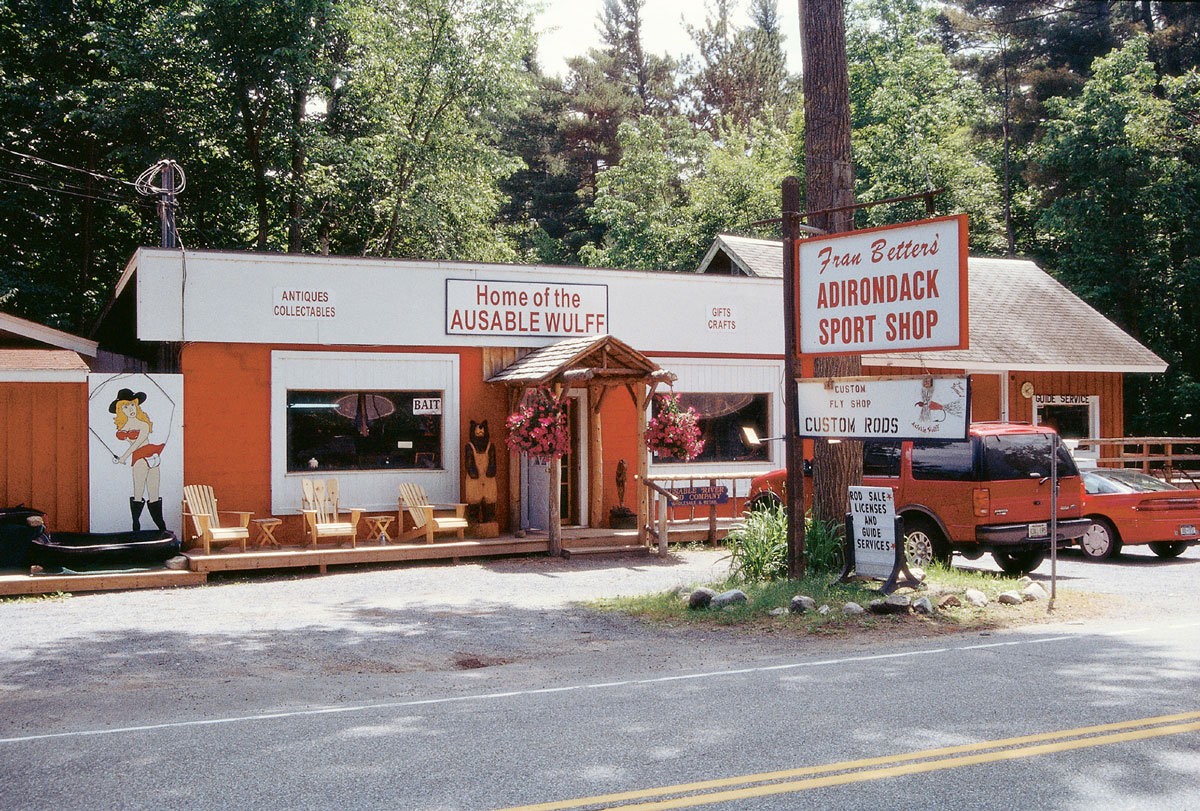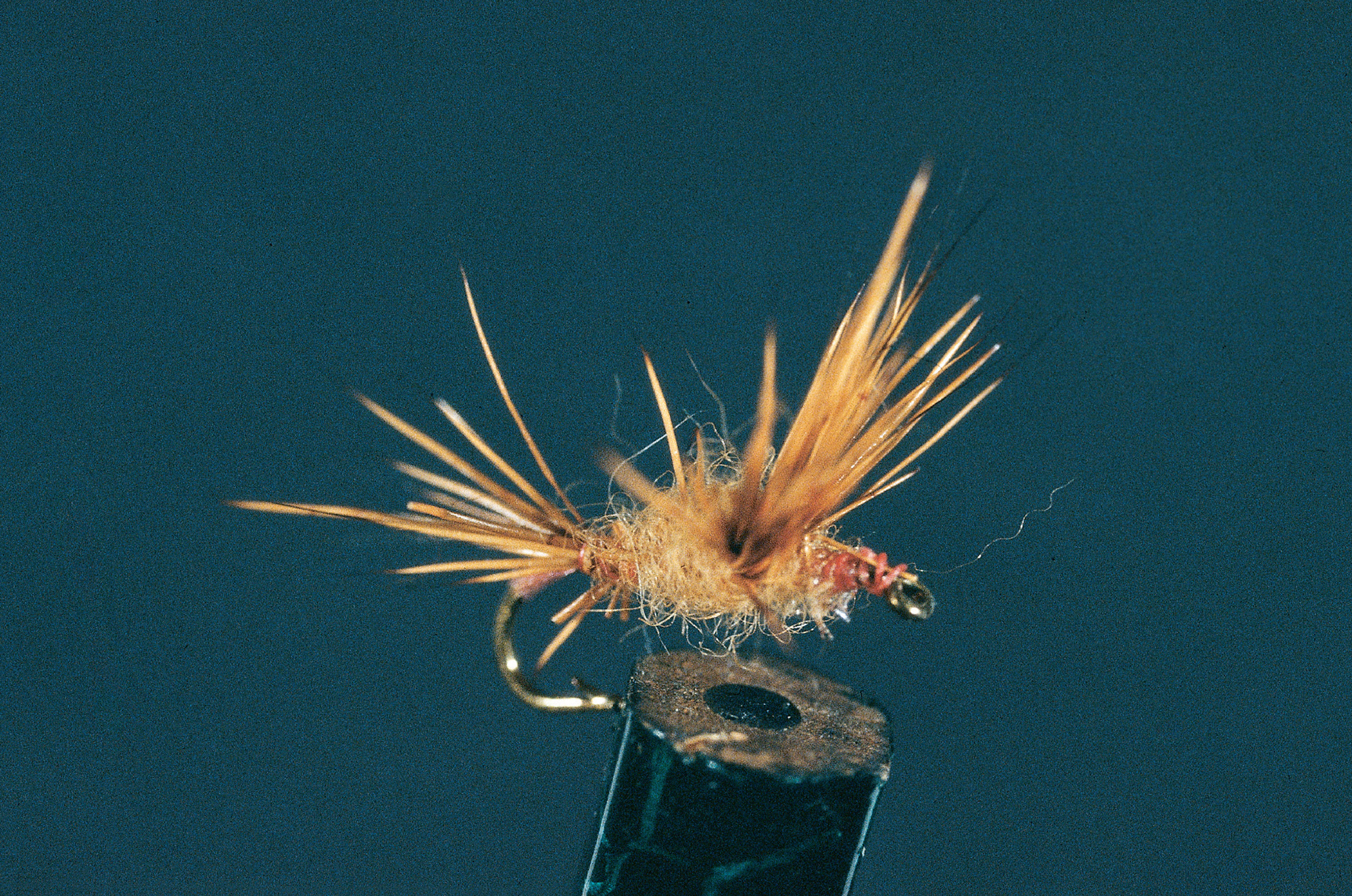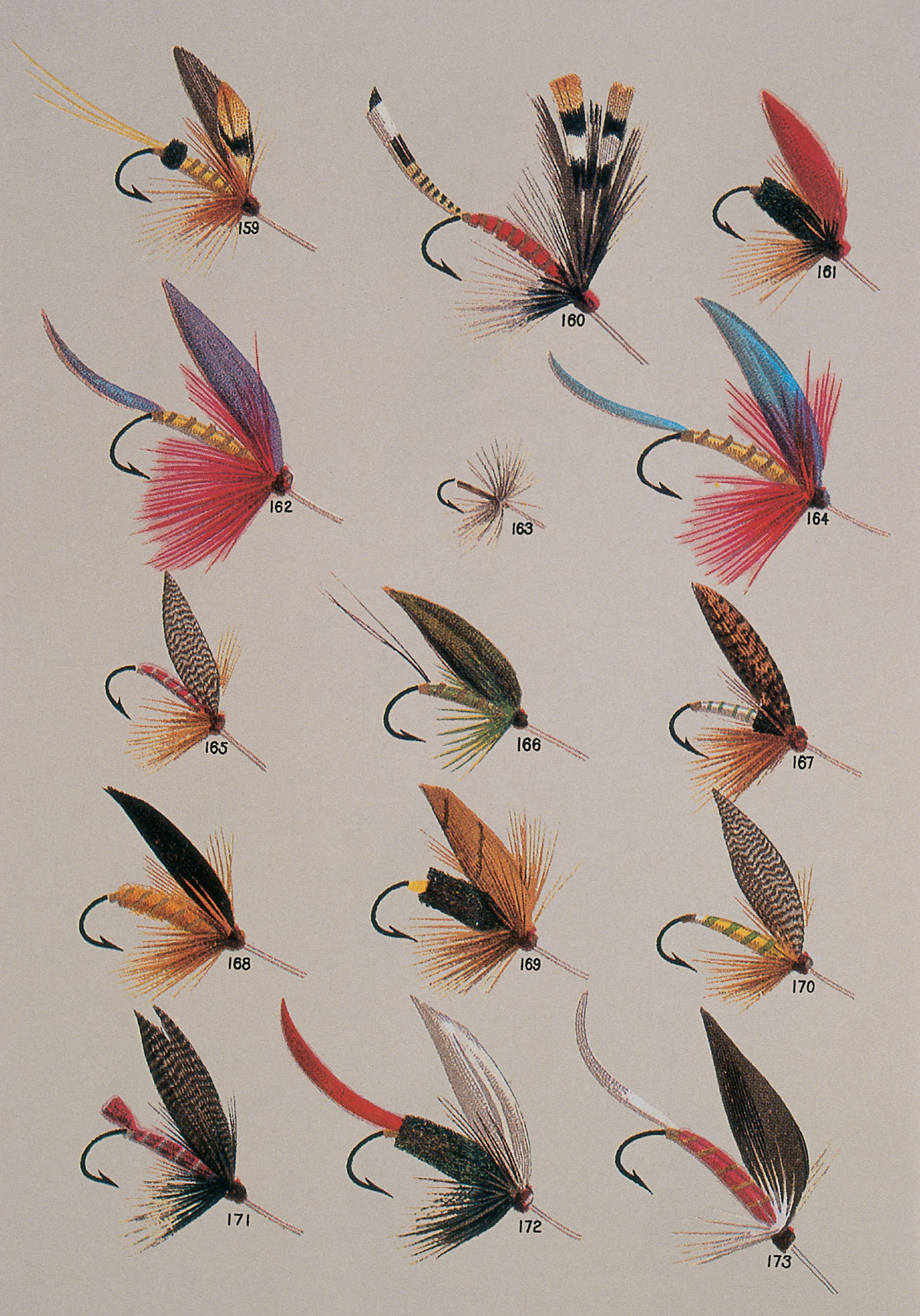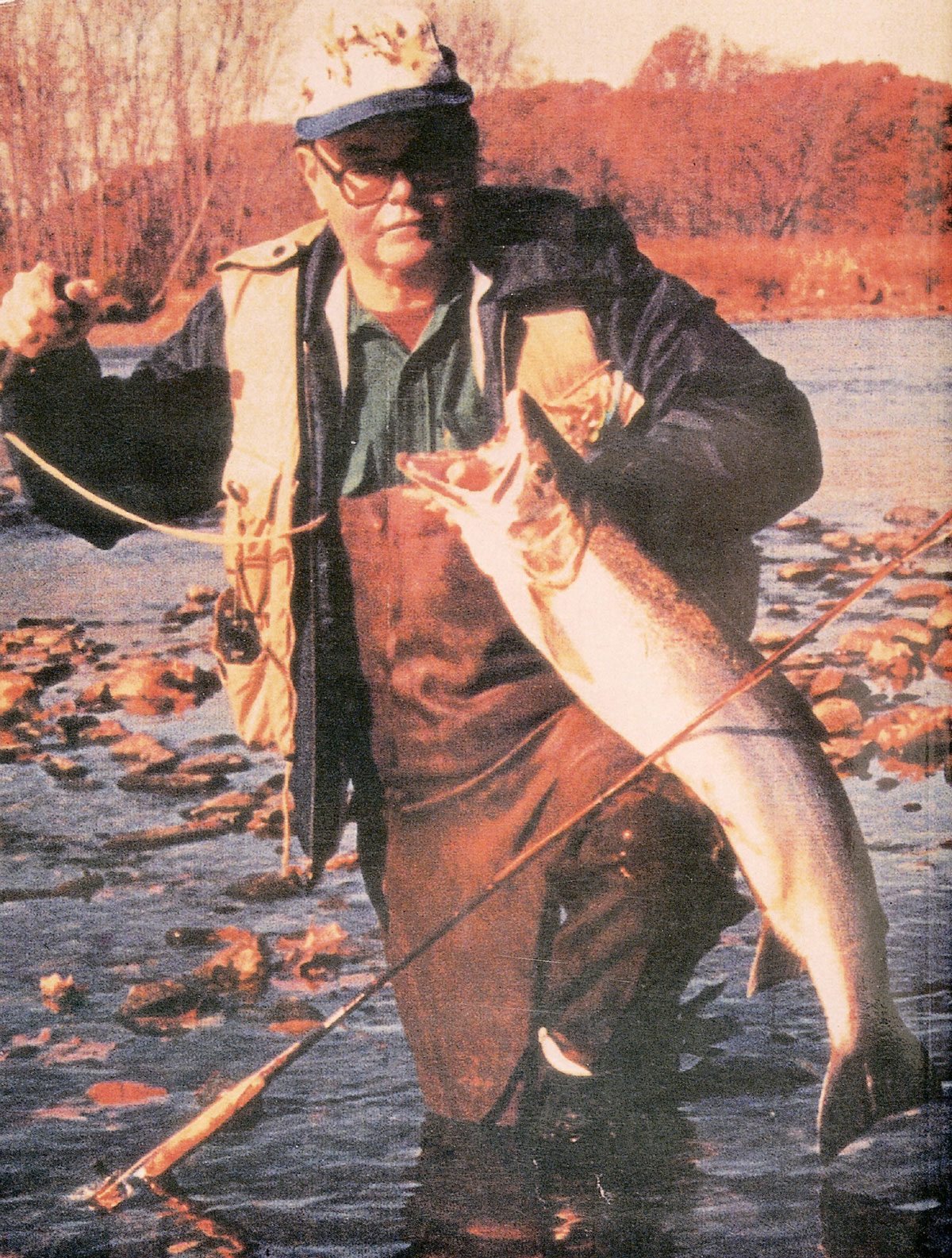Streambeat
Fran Betters and the mysteries of streamside representation
Joseph Grigely
Fran Betters isn’t likely to become a household name any time soon. Not in the art world anyway. He lives in the Adirondack Mountains in upstate New York, a couple of casts from the famed Ausable River. He grew up trout fishing on the Ausable in the 1930s and 1940s, alongside the craftsmen of fly fishing like Ray Bergman, the prototypical outdoorsman/author whose Trout, first published in 1938, is considered a canonical book on the subject. Fran is canonical too, not as a fisherman but as a fly-tier: since the 1940s, his flies have developed an enduring reputation among insiders for their idiosyncratic originality. Fran’s flies have names like “Haystack” and “The Usual” and they don’t look anything like the flies you can buy at outfitters like Orvis in the US or Hardy’s in Britain. Instead they look like shoddy, slapdash bits of fur and hair, more like something the family cat would cough up on the living room chair.
Trout flies generally occupy a place outside mainstream conceptions of the applied arts. You won’t find them in the Cooper-Hewitt Museum or even the Smithsonian, but rather have to travel to the American Museum of Fly Fishing in Manchester, Vermont to experience studied displays of the history and aesthetics of fly fishing. The sport is usually regarded as a residual bourgeois tradition that began in the British Isles in the seventeenth century. The bourgeois beginnings have a reason: In England, all waters are considered private in the sense that they belong to somebody, and can be fished only by permission or by deed. This made poaching an honorable kind of counter-tradition, memorialized by the fact that the unofficial British record for Atlantic salmon, a sixty-seven-pound specimen, was caught in 1812 by a poacher named Jock Wallace. What makes fishing democratic in the end is its cultural ubiquity. It has history and tradition, stories of good guys and stories of bad guys; it has innovators and usurpers, big fish and little fish, and fish that got away. There is an enlightening moment in Norman Maclean’s novella A River Runs Through It, where Maclean’s younger brother Paul reassesses the achievement of Izaak Walton’s famous seventeenth-century meditation on trout fishing, The Compleat Angler, with a singularly astute observation: “The bastard doesn’t even know how to spell ‘complete’.” Even James Joyce had a predilection for fly fishing, or if not, at least for the sport’s lexicography. For decades, scholars were puzzled about why Finnegans Wake names more than a thousand rivers and lakes and related bodies of water—and it was only recently in the New York Times that Robert Boyle pointed out that Finnegans Wake is “awash with fishy phrases” that begin with the novel’s first word, “riverrun.”[1] Boyle has tracked 2,200 allusions to fish and fishing, for an average of 3.5 per page. “You spigotty anglease?” Joyce asks at one point in Finnegans Wake, which is to say, “Do you speak fishermen’s slang?” If not, it’s not a bad idea to learn.
One reason is because fishing, fly fishing in particular, offers an important approach to understanding the permutations of representational theory. Fly fishing is predicated on the notion of similitude: trout eat aquatic and terrestrial insects—primarily mayflies, caddis flies, stoneflies, and also wayward ants—and trout flies are typically tied to match a particular insect. Trout can be difficult, not to mention finicky. When a hatch of mayflies is occurring, and nymphs emerge as flying duns and begin their mating flights above the stream, trout will often refuse all flies not matching that particular insect’s size and coloration. As Doug Swisher and Carl Richards wrote in their appropriately titled study of trout habits, Selective Trout, “The right fly is one that resembles the natural so closely that the fish seem to prefer it over the real thing.”[2] For this reason, “imitations” (as such flies are called) predominate in the typical fisherman’s flybox.

Which is why Fran’s flies are so compelling: They don’t imitate any particular insect. They’re dowdy and disheveled, if not bad-ass ugly, and go against the grain of America’s match-the-hatch philosophy and tradition that started in the Catskills in the late nineteenth century when Theodore Gordon tied his first “Quill Gordon” to imitate Epeorus pleuralis.[3] There is no Latin in the world of Fran Betters. Nor is their nuanced entomology. Identifying classes of insects is as far as he goes, and he does so with a pragmatic kind of backwoods experience expressed in upstate New York similes: “Caddis flies are quite often mistaken by fishermen for moths. They can best be identified by their erratic flight pattern, seemingly to be flying in every direction at the same time, as if they were drunk.”[4]
One look at Fran’s flies and you’d think the person who tied them was drunk too. The Haystack pattern, which Fran conceived in 1949, consists of a bit of fine deer hair for the tail, a larger gob of splayed deer hair for the wings, and some dubbed Australian possum fur for the body. The shading can be light or dark; the deer hair can be tied in dense or sparse; the wrapping thread can be black or hot orange. You can tie one really fast (Fran can do it in about two minutes if he’s in a hurry) or really slow. As Fran puts it, “Tying the fly can be learned in a short time by anyone with the dexterity to tie his own shoelaces.”[5]
There aren’t many patterns in Fran’s oeuvre, and the Haystack is probably his most imitated. In the 1970s, two tiers named Al Caucci and Bob Nastasi usurped Fran’s design, gave it a haircut and clean lines, and rechristened it the “Comparadun.” Partly because it has been marketed so widely, the Comparadun is a better-known fly. But the Comparadun lacks Fran’s sense of composite unspecificity, as if it is trying too hard to be what it is not. Fran’s other well-known flies include the “Ausable Wulff” (an adaptation of a famous Lee Wulff pattern that looks like no particular insect), The Usual (like the Haystack, a very buoyant dry fly tied using fur from the foot pads of snowshoe rabbits), and the “Mini-Muddler” (a slipshod adaptation of Don Gapen’s famous “Muddler Minnow,” a fly already so ugly that, as Fran says, it “would probably be considered ugly by anyone but a Muddler’s mother.”)[6]
It’s hard to believe that flies like the Haystack can catch trout—especially when held up against flies more exactingly tied to match naturals. Part of the mystery can be found in understanding a traditional and, to some extent, neglected kind of fly called the “attractor” pattern. Unlike imitation patterns, the attractor does not imitate a specific insect, but is instead tied to attract, perplex—even aggravate—trout into striking. Deceiving fish is not simply about presenting them with representational illusions, but also about playing psychological games—throwing them off balance, and using their own curiosity and anger against them. The originator of the famous attractor pattern known as the “Paramanchenee Belle” (which looks like the belly fin of a speckled trout) used to say to his fishing companion in the late nineteenth century: “Well, John, what shall we tease them with this afternoon?”[7] Flies like the “Mickey Finn” (tied with red and yellow bucktail) and the “Royal Coachman” (tied with peacock herl and scarlet floss) have a long history, but they aren’t usually found in the fly-boxes of the match-the-hatch fishermen. They’re beautiful, seductive flies though. Even the names of attractors can be seductive: “Whirling Blue Dun,” “Silver Doctor,” “Wickham’s Fancy.” As Fran puts it, and as most fly fishermen know, there are basically two types of flies: “those that are tied to catch fish and those that are tied to catch fishermen.”[8]

Which isn’t to say that attractor patterns don’t catch trout—they do. This is a clue to the success of Fran’s flies: They attract trout not because they are outlandishly or exactingly tied, but because of their behavioral qualities. The Haystacks sit low on the water, usually in the surface film, and can be easily skittered across the surface and fished in a variety of ways, as a drifting dry fly, as a swimming wet fly, or as an emerging nymph. They do not imitate the appearance of a specific insect, but rather imitate the behavior of classes of insects. Fran’s approach thus has a lot less to do with the match-the-hatch crowd than with a certain Arthur H. E. Wood, an English engineer and salmon fisherman who in the early 1900s experimented with floating lines (made from greased silk) and casting techniques to make flies drift unimpeded by the line or leader. Much of Wood’s work was collected and published under the pseudonym of Jock Scott in 1935, a year after Wood died. Wood’s departure from existing traditions was to fish in a way as to make the fly behave naturalistically: “As there is little a fish does not see, the fly ought to behave naturally all the time, as an insect or other live creature would do in the water.”[9] For Wood, the idea of a realistic imitation is more than visual resemblance to how an insect looks; it also involves how the fly behaves in the water, and how the fisherman, in the process of casting and manipulating the fly, inflects this behavior.
The lesson here is an important one. In the emergent field of visual studies, discussions about representational theory have slowly pushed past the art-image as the dominant source material. As W. J. T. Mitchell writes in Picture Theory, the “pictorial turn” is an omnipresent part of the study of culture, and (though he doesn’t quite say it in so many words), this approach extends itself to the varieties of images and imagery that punctuate our daily lives: “images tout court, across all boundaries,” as James Elkins put it.[10] Yet our attraction to the image is also an attraction to the static image, and this is limiting. At one point in Picture Theory, Mitchell poses a question that is elemental to this subject: “Try putting a realistic photograph of a worm on a hook and see how many fish bite at it.”[11] The problem with a photograph of a worm—and this is something even a fish can understand—is that it doesn’t move like a worm. That it doesn’t feel like a worm or smell like a worm are also important issues. In the end, mere figuration isn’t going to put fish in the creel. The “natural” world of fish and flies and worms and water is a world marked by movement. It is characterized by hydrodynamic actions: swimming, floating, skittering, drowning, dragging. Fran’s flies are important to a critical theory of visual representation because they introduce representation as a dynamic construction: it’s not the image alone that matters, but the way the image moves.
Nelson Goodman is one of the few critical theorists to understand just how complex this is. I don’t know if Goodman ever fished, but he did recognize that the process of imitating animate beings was a selective process—that no being can be represented “in the fullness of its properties.”[12] This sounds a lot like Bergman in Trout: “As a matter of fact I believe that it is impossible to create an artificial DUPLICATE of a natural insect.”[13] In their own ways both Goodman and Bergman remind us that a trout fly can only be a representation of an actual fly, not a representation of it. Short of tying real mayflies and nymphs on hooks—a strategy impractical for all but the largest stone flies—how does the fly fisherman imitate through subterfuge and prestidigitation the complex array of delicate and animate properties of streamside creatures?

One approach involves tying flies that will most likely appeal to a fish in a given situation. It’s not so much about imitating flies as it is about creating desirable fictions. This is why certain “dressings” (as fly patterns are known) require the use of unique natural materials that can sometimes be difficult to obtain. The properties of snowshoe rabbit foot fur (wiry, naturally dun-colored and waterproof, and essential to the Usual) or hair from the back of the neck of the Florida Key deer (preferred for Fran’s Haystacks because it is finer than most deer hair and highly buoyant, though unfortunately from an endangered species) or even the urine-stained fur from a female red fox (required for Art Flick’s version of the Hendrickson dry fly) cannot be replicated through the use of alternative materials. Other materials may look like reasonable substitutes, but in water, their behavioral properties (translucence, water repellence, stiffness, and so on) are not always the same. This would suggest the inevitability of representational gaps: that the totality of a sign is incommensurate with the totality of that which it represents. Trout flies have long emphasized size, shape, and color, in part because streamside entomological study is based upon the identification of prevailing insects rather than a nuanced, Muybridge-like study of how they move through a stream. Neither art history nor media studies have given us the critical tools to discuss the complexity of such densely layered signification. One could perhaps turn to linguistics for some assistance here. A visual language like American Sign Language (ASL) predicates meaning on a phonological system that combines specific handshapes in relation to passive and active movement. A sign becomes meaningful in relation to its embeddedness as a cognitive process—which is how one can discriminate between a meaningless gesture and a meaningful sign. As, one supposes, a trout can discriminate between a Hendrickson mayfly and a little blob of fur and feather tied to a hook.
For the fisherman standing streamside, selecting a fly is ultimately a discursive experience. If the task were simply to select a fly that “looks like” the naturals found on the stream, the experience would merely be a hermeneutic one. In fact, it is much more like a deconstructive process. You think as you go, and react to the possibilities that the stream and the flies simultaneously present. It’s not that there are a lot of choices; it’s rather that there are a lot of possible inflections to a few choices. Bergman, whose authority on fly fishing still reigns after more than sixty years of subsequent innovation, argued that nuance means everything and nothing, and that human logic cannot reduce to a succinct representational theory the reasons why trout take flies. “Perhaps some day we shall know all the answers,” he wrote, “but I hope we never do.”[14]

Like Bergman, Fran is a pragmatist, and he too writes in a kind of meandering and easygoing prose. His best-known book is Fran Betters’ Fly Fishing, Fly Tying and Pattern Guide (second edition, 1986)—a compendium of patterns and advice, all told in a sincere northwoods drawl. It’s self-published, but this is nothing to scoff at. The Adirondack region has a long and enduring tradition of backwoods seers self-publishing, if not also self-printing, their own treatises on the outdoors. At bookshops and antique shops throughout the Adirondacks, one can find monographs and mimeographs on trapping, deer hunting, bear tracking, log lean-to construction, and pretty much anything that has to do with the woods (recipes for homemade blackfly repellants seem to be among the more desirable of such publications).[15] Fran’s book covers a lot of territory, emphasizing, as he says, “ways of applying common sense and simplicity to an art that has been made to appear complicated.”[16] There’s an uncanny kind of prescience in how Fran writes about streams and the practice of “reading water”—he reads streams the way Derrida reads texts. This isn’t the facile analogy it might seem to be: Fran, like Derrida, takes a certain pleasure in the challenges posed by the vicissitudes of his stream/text. There is very little closure in Fran’s world: “The fly fisherman who doesn’t have a little gambling blood in his veins and who doesn’t attack the stream aggressively will have poor results more often than not.”[17] This sounds like Derrida sparring with Rousseau in De la Grammatologie. Fran also writes pretty poetry and some rather unpretty recipes (his Adirondack Fish and Game Recipes includes recipes for Road Kill Stew, Roast Raccoon, and Bear Sauerbraten), and the deeper you get into his texts and his platitudes, the more humanized and endearing he becomes. His isn’t the free-wheeling political kind of revolutionary spirit like that of Noah John Rondeau, who for thirty years in the early 1900s lived and trapped along the Cold River and became known as the “Adirondack Hermit.” Fran’s is a different kind of Adirondack spirit: easygoing, unpretentious, and always happy to share a story.
Fran’s shop is located outside the village of Wilmington, New York, along Route 86, just downstream a bit from the Flume Pool bridge. Out front there’s a big sign that says “Adirondack Sport Shop” and “Home of the Ausable Wulff,” and right nearby there’s a larger-than-life image of a bikini-clad cutie whose miscast has hooked her own tail. This kind of indecorum can keep one driving down the road to the competition nearby (the Ausable River Sport Shop is a half mile downstream; The Hungry Trout Fly Shop is a half mile upstream). If you venture inside—and lots of people have since the shop first opened in 1963—you’ll find Fran seated behind a large tying desk, a panoply of fur and feathers around him, and a conversation in the air (Fran ties his flies and talks with his customers at the same time). You can tell him what you want, and he’ll tie it for you then and there. Or, better, you can ask him what he thinks you’ll need, and he’ll probably place in your palm a fly he tied a moment earlier. It’s not often you can get so close to a legend.
- Robert H. Boyle, “You Spigotty Anglease?” The New York Times Book Review, 23 July 2000, p. 27.
- Doug Swisher and Carl Richards, Selective Trout: A Dramatically New and Scientific Approach to Trout Fishing on Eastern and Western Rivers (New York: Crown, 1971), p. 2.
- Gordon was influenced by England’s F. M. Halford, who wrote two books widely considered to be seminal texts in match-the-hatch philosophy: Floating Flies and How to Dress Them (1886) and Dry Fly Fishing in Theory and Practice (1889).
- Fran Betters, Fran Betters’ Fly Fishing, Fly Tying and Pattern Guide, 2nd ed. (Wilmington, NY: Ausable Wulff Products, 1986), p. 33.
- Ibid., p. 37.
- Ibid., p. 61.
- Mary Orvis Marbury, Favorite Flies and Their Histories (Secaucus, NJ: The Wellfleet Press, 1988), p. 157.
- Betters, Fran Betters’ Fly Fishing, p. 36.
- Jock Scott, Greased Line Fishing for Salmon (London: Seeley Service & Co. Limited, 1935), 3rd edition, p. 84.
- Elkins’s remark can be found in his book Visual Studies: A Skeptical Introduction (New York: Routledge, 2003). See also Elkins’s The Domain of Images (Ithaca, NY: Cornell University Press, 1999) for a discussion of the relationship between art and “non-art” images.
- W. J. T. Mitchell, Picture Theory (Chicago: University of Chicago Press, 1994), p. 331. As far-fetched as it may sound, photographs have in fact found their way onto fish hooks in recent years. A certain desirable feather from the neck of the Indian jungle cock is an imperative part of flies as diverse as a jassid (a terrestrial insect) and a “Grey Ghost” (a streamer pattern that imitates forage fish like smelt). The jungle cock “eye” is required by many other patterns, but the bird, driven close to extinction in its native habitat, has been illegal to import to the US for decades. To supply jungle cock imitations, photographic images are printed on strips of clear mylar, which can then be cut and tied in a pattern. Domestically bred jungle cock is now legal in both the UK and US, and though not prohibitively expensive, it has not displaced mylar jungle cock.
- Nelson Goodman, Languages of Art (Indianapolis: Hackett Publishing, 1976), p. 9.
- Ray Bergman, Trout (New York: Knopf, 1947), p. 154.
- Ibid., p. 239.
- One of the best sources for Adirondack-specific publications is the bookshop With Pipe and Book, 91 Main Street, Lake Placid, NY 12946. Tel. 518-523-9096.
- Betters, Fran Betters’ Fly Fishing, p. iii.
- Ibid., p. 19.
Joseph Grigely is an artist who is represented by Cohan and Leslie, New York; Air de Paris, Paris; and Masataka Hayakawa, Tokyo. He is professor of visual and critical studies at the School of the Art Institute of Chicago. His publications include Textualterity (University of Michigan Press, 1995).
Spotted an error? Email us at corrections at cabinetmagazine dot org.
If you’ve enjoyed the free articles that we offer on our site, please consider subscribing to our nonprofit magazine. You get twelve online issues and unlimited access to all our archives.